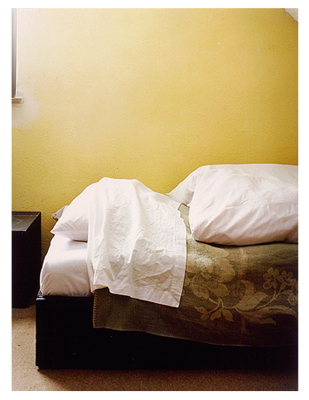| Thomas Ruff Interieur 14B (Interior 14B), 1980 |
| Photograph | C-Print |
| 27.2 x 20.3 cm |
 |
| “Interieur 14B” and “Interieur 2C” belong to the “Interiors” series which Thomas Ruff began work on in the early 80s, alongside his series of buildings and portraits. All three series share the same sober, austere treatment. In “Interieur 14B” the image shows the head of a bed standing alone from an almost frontal viewpoint. The bed is made, with pillow and blanket. On the left, we can partly discern a low piece of furniture and what might be a window frame because of the light coming through it. In “Interieur 2C” we can see one of the sides of a wash basin, also from an almost frontal viewpoint which blocks us from seeing the interior. All we can see is the tap, the soap dish and the chain for the plug. One of the outstanding features in this series is the composition, the formal aspects of the image and the ordering of the different elements that shun any possible romantic reading linked to the traces left by the people who lived there. Both “Interieur 14B” and “Interieur 2C” are flat, sharp images with no depth or element to disturb the order, with no signs of being a space where people live and no possible incidents there. As in other images from the same series, these interiors show fragments of rooms, home interiors and possible settings for family events, but instead of providing the background for a collective portrait the settings in these images move to the foreground and become the focus of attention in a totally aseptic way. Ruff feels that his work has always had a political aspect, and in referring specifically to this series he says: “I’d say my work has always been political. In the Interiors, for instance, I was looking at the surroundings I grew up in ‘with a laughing and a crying eye’.” The fact that the images do not provide any evident incident means that the spectator’s eye scrutinises them trying to find the trick, the trap. But the images resist any attempt to insert them into a possible narration which might explain the period, the years or the number of people who live there. Just like with the series of portraits, Ruff first used the spaces he had on hand as subjects for his camera, such as his own and those of his friends. The formal treatment of the image brings about such ‘objectivisation’ of the content that his friends did not recognize the place. As he himself said in an interview: “Friends of mine stayed the night in various apartments that I’d photographed and they didn’t recognize the place. The photograph had condensed reality to such an extent that they didn’t recognize real reality”. Indeed, one of the effects Ruff’s photographs produce – and specifically in this series – is the condensation of reality. The resulting image becomes an autonomous reality, a reality independent of its referent. |
Neus Miró
|

